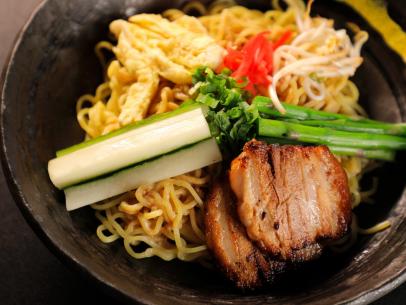
Recipe courtesy of
Kathleen Brennan
for
Food Network Kitchen
Recipe courtesy of
Kathleen Brennan
for
Food Network Kitchen
Watch how to make this recipe.
Hiyashi Chuka
Getting reviews...
- Level: Easy
- Total: 35 min
- Active: 30 min
- Yield: 4 servings
-
- Nutritional Analysis
- Per Serving
- Serving Size
- 1 of 4 servings
- Calories
- 1012
- Total Fat
- 53 g
- Saturated Fat
- 16 g
- Carbohydrates
- 104 g
- Dietary Fiber
- 6 g
- Sugar
- 15 g
- Protein
- 31 g
- Cholesterol
- 160 mg
- Sodium
- 4764 mg
Although hiyashi chuka literally means “chilled Chinese,” this cold ramen salad is actually a Japanese dish, traditionally served during the summer. Consisting of cold ramen noodles, a colorful variety of thinly sliced toppings and a soy sauce or sesame–based dressing, it is light, refreshing and easy to assemble. Ham, surimi, cucumbers, tomatoes and egg crepe are common ingredients, but feel free to make whatever substitutions you like. You can also use fresh or dried ramen noodles. Although fresh noodles cost more, need to be refrigerated and aren’t as readily available, I think they have the slight edge here, thanks to their springy texture and ability to better absorb the sauce. Try both types and see which one you prefer.
- Level: Easy
- Total: 35 min
- Active: 30 min
- Yield: 4 servings
-
- Nutritional Analysis
- Per Serving
- Serving Size
- 1 of 4 servings
- Calories
- 1012
- Total Fat
- 53 g
- Saturated Fat
- 16 g
- Carbohydrates
- 104 g
- Dietary Fiber
- 6 g
- Sugar
- 15 g
- Protein
- 31 g
- Cholesterol
- 160 mg
- Sodium
- 4764 mg
Ingredients
Sauce:
Kinshi Tamago (Shredded Egg Crepes):
Assembly:
Directions
- For the sauce: Whisk together the soy sauce, vinegar, sesame oil, sugar, ginger and 3 tablespoons water in a medium bowl until the sugar dissolves. Cover and refrigerate until needed.
- For the kinshi tamago (shredded egg crepes): Whisk together the eggs and a pinch of salt in a small bowl. Strain through a fine-mesh strainer into another small bowl. (This isn’t essential but yields a smoother crepe without any pockets of egg white.)
- Heat an 8-inch nonstick skillet over medium-low heat. Lightly wipe the surface of the skillet with a folded-up paper towel dipped in some oil.
- Add about 3 tablespoons (see Cook’s Note) of the beaten eggs and immediately and quickly tilt the skillet in all directions until the eggs evenly cover the bottom. Cook until the eggs are just set, about 20 seconds. Carefully flip the sheet of eggs with a spatula, using your fingers as needed, and smooth out any wrinkles. Cook until the bottom of the eggs are just set, about 5 seconds more.
- Transfer the sheet of eggs to a cutting board. Repeat the process 2 more times, re-oiling the skillet between batches and stacking the sheets on top of each other.
- Roll the sheets into a log and cut crosswise into 1/8-inch slices. Gently separate the strands with your hands.
- For the assembly: Bring a large pot of water to a boil over high heat.
- When the water comes to a boil, boil the noodles according to the package instructions. Drain the noodles, then rinse with cold running water, tossing them with your hands, until completely cool and all the excess starch is removed. Drain thoroughly. (Any excess water will dilute the sauce.)
- Divide the noodles among 4 shallow bowls. Arrange the ham, surimi, tomatoes, cucumbers and kinshi tamago over the noodles in sections. Sprinkle the sesame seeds on top and place a dollop of karashi, if using, on the side of each bowl. Serve with the chilled sauce to pour over the noodles as desired.
Cook’s Note
When you measure the beaten egg, do so in a 1/4-cup measuring cup; the mixture cooks too quickly for you to evenly swirl it around if you measure and pour in 3 separate tablespoons. You can also just eyeball the amount, adding the mixture to the skillet in thirds.

































